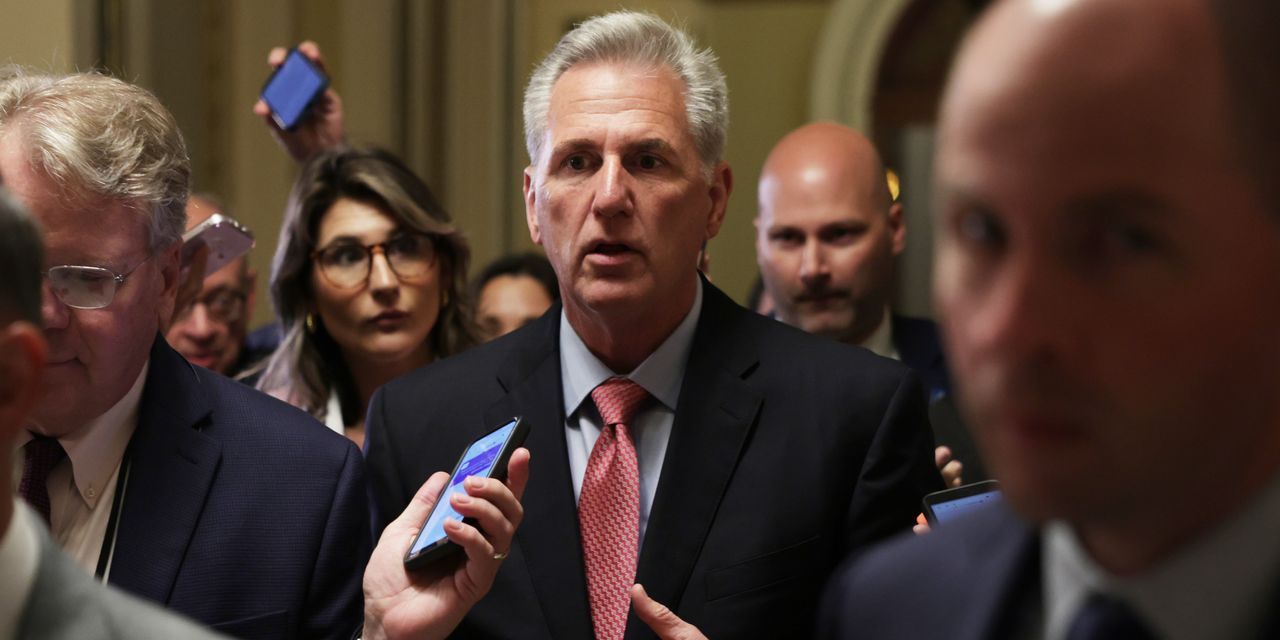About the author: Leslie Lipschitz is former director of the IMF Institute, has taught at Johns Hopkins University and Bowdoin College, been a guest scholar at the Brookings Institution, and an advisor at Investec Asset Management.
House Republicans recently passed a bill that subjects the raising of the federal debt ceiling to numerous conditions, especially a large reduction in federal spending. Those politicians are appealing to genuine voter disquiet about the economy and the seemingly inexorable rise in government debt. It’s important to understand the political foundation of this fiscal indiscipline, because, however the debt-ceiling issue is resolved, the longer-term outlook is troubling. The stakes are higher than many in Congress understand.
The U.S. benefits from so-called exorbitant privilege. The dollar is the currency in which most trade is settled; Treasury debt is perceived as the global safe asset so it bulks large in the official reserves of other countries and in private portfolios; and dollar settlements and swap arrangements between the Fed and other central banks are fundamental to the global financial system. As a result, the U.S. can finance consumption and investment by exporting dollars that others want to hold. But some countries resent this exorbitant privilege—as evidenced by Russia and China seeking to settle payments in their own currencies. It can only be sustained by policies that ensure the financial sustainability and credibility of the U.S. government.
Market economies fluctuate. Policies should moderate booms and busts. When output and demand are booming, fiscal policy automatically withdraws stimulus through the increased tax receipts (from the higher incomes) and lower spending on unemployment insurance and poverty alleviation. In recessions, automatic fiscal stabilizers increase stimulus. Sometimes governments need to enhance automatic withdrawals and injections of stimulus through discretionary actions.
A sensible and symmetric fiscal policy would more or less balance the budget over the cycle: deficits in recessions and offsetting surpluses in booms. Most economists would subscribe to such a policy, but it bears little resemblance to recent history.
Instead, there is a fiscal policy ratchet—easy to stimulate, difficult to contract. It is normal for government debt to rise; it becomes worrisome when it increases much more rapidly than economic output. U.S. general government debt was about 55% of gross domestic product in 2002; a decade later the corresponding figure was 103%; in 2022 it exceeded 121%. Projections show a rising trend.
What explains this increasing indebtedness? In boom times, there are powerful lobbies—both Republican and Democrat—against fiscal retrenchment. They argue that the economy has undergone a structural shift, that output well above the historical trend is the new normal. Democrats see an opportunity to spend the windfall and Republicans an opportunity to cut taxes. The lobbying is asymmetric: The opposition to fiscal stimulus in recessions is negligible among both Republicans and Democrats.
The House plan is, presumably, aimed at breaking this pattern. The plan is called The Limit, Save, Grow Act, and it would need to also pass the Democratic-controlled Senate to become law. Its specific proposals amount to policy spending cuts of about $1 trillion over 10 years. Of this, abolishing student debt cancellation (a saving of some $460 billion) is sensible. The other items are either irresponsible (reversing action on energy and climate change), ill-considered (savings from changes to Medicaid and food stamps are small relative to their detrimental welfare effects), or downright silly (cutting Internal Revenue Service funding actually leads to a $120 billion net loss). But the total policy saving of $4.2 trillion over 10 years reflects an additional cut in unspecified discretionary spending of $3.2 trillion—that is a reduction of almost 18% from the baseline. If one exempted defense from cuts, those in other discretionary categories would need to drop by almost a third–a figure that belies credibility. Buried in this plan, therefore, may be implicit changes in social security and medicare. Legislators will balk at specific cuts when the implications for voters are made clear.
It is inconceivable that government deficits, and the corresponding rise in government debt, can be curtailed without both expenditure restraint and tax increases. The economic question is this: How can deficits and debt be contained with the least detrimental impact on growth and wellbeing? For politicians, both Republican and Democrat, there is never an ideal time for serious fiscal restraint. This is why the House plan is so incomplete.
U.S. budgetary problems are too complex and fundamental for an answer to be cooked up in a few weeks of party politics aimed at mollifying extremes.
A sensible approach would be to raise the debt ceiling while establishing a standing committee of fiscal experts charged with two tasks.
First, reassessing the entire fiscal structure: spending priorities, taxes versus debt financing of these expenditures, and the opaque and overly complicated tax system. Ideally, this would lead to a simplification of taxes (less reliance on direct taxes and—like all other advanced countries—greater reliance on a value added tax), a serious culling of tax expenditures, and cuts in some categories of spending protected by powerful lobbies.
And, second, establishing guardrails to limit the asymmetry in countercyclical fiscal policy by clearly-articulated countercyclical objectives—perhaps a cyclically-adjusted budget that is consistent with debt-stabilization.
The committee’s mandate would need to be broad: beyond projecting revenue and spending, it would propose realistic strategies for achieving specified objectives and provide numerical reports on progress. Its political profile would need to be high—requiring Congress to link appropriations with financing, to set fiscal targets, and to debate both the committee’s assessment of how these can be achieved and how deviations from these targets can be corrected. It would thereby introduce political accountability and provide cover for those who want to do the right thing and still be reelected.
However sensible this proposal is, it would face daunting obstacles. In the current Congress, even if such a committee could be established, and even if its advice were wise, its proposals would be stymied by the dominant voices of the rigid left and right extremes.
These reflections are profoundly pessimistic. The likely path is a continuation of the current muddle-through approach, postponing the reckoning till later. The U.S. economy has reserves of strength, and policy inertia will probably not seem apocalyptic. However, the rise in debt will increasingly curtail the government’s ability to deal with economic shocks; and an insidious erosion of U.S. credibility and the standing of the U.S. dollar will take an eventual toll. Deep reforms will probably not gain traction until a crisis hits. But our democracy and role in the world would be better served by clear-sighted policy makers capable of sustaining our economic strengths and forestalling crises rather than reacting to them.
Guest commentaries like this one are written by authors outside the Barron’s and MarketWatch newsroom. They reflect the perspective and opinions of the authors. Submit commentary proposals and other feedback to [email protected].
Read the full article here




